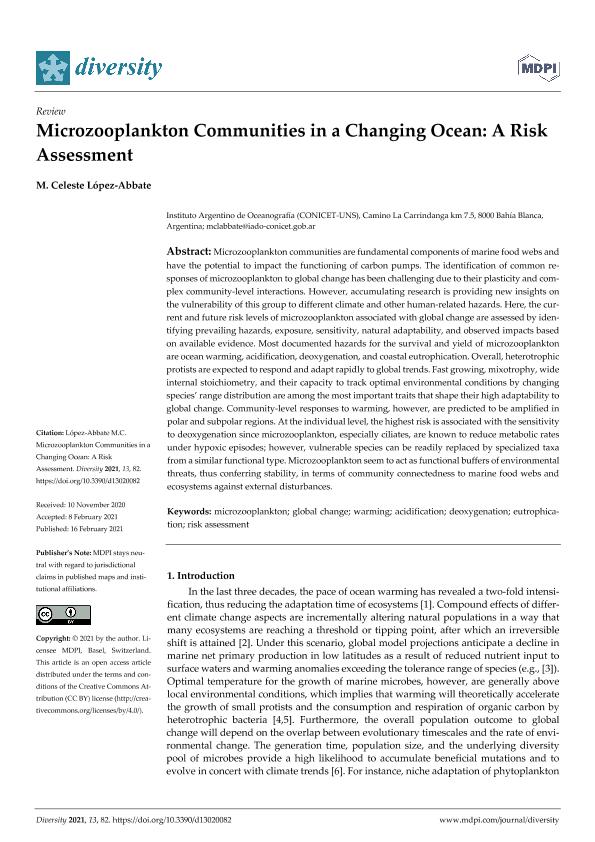Mostrar el registro sencillo del ítem
dc.contributor.author
López Abbate, María Celeste

dc.date.available
2022-05-30T13:29:52Z
dc.date.issued
2021-02-26
dc.identifier.citation
López Abbate, María Celeste; Microzooplankton Communities in a Changing Ocean: A Risk Assessment; MDPI; Diversity; 13; 82; 26-2-2021; 1-26
dc.identifier.issn
1424-2818
dc.identifier.uri
http://hdl.handle.net/11336/158466
dc.description.abstract
Microzooplankton communities are fundamental components of marine food webs and have the potential to impact the functioning of carbon pumps. The identification of common responses of microzooplankton to global change has been challenging due to their plasticity and complex community-level interactions. However, accumulating research is providing new insights on the vulnerability of this group to different climate and other human-related hazards. Here, the current and future risk levels of microzooplankton associated with global change are assessed by identifying prevailing hazards, exposure, sensitivity, natural adaptability, and observed impacts based on available evidence. Most documented hazards for the survival and yield of microzooplankton are ocean warming, acidification, deoxygenation, and coastal eutrophication. Overall, heterotrophic protists are expected to respond and adapt rapidly to global trends. Fast growing, mixotrophy, wide internal stoichiometry, and their capacity to track optimal environmental conditions by changing species? range distribution are among the most important traits that shape their high adaptability to global change. Community-level responses to warming, however, are predicted to be amplified in polar and subpolar regions. At the individual level, the highest risk is associated with the sensitivity to deoxygenation since microzooplankton, especially ciliates, are known to reduce metabolic rates under hypoxic episodes; however, vulnerable species can be readily replaced by specialized taxa from a similar functional type. Microzooplankton seem to act as functional buffers of environmental threats, thus conferring stability, in terms of community connectedness to marine food webs and ecosystems against external disturbances.
dc.format
application/pdf
dc.language.iso
eng
dc.publisher
MDPI
dc.rights
info:eu-repo/semantics/openAccess
dc.rights.uri
https://creativecommons.org/licenses/by/2.5/ar/
dc.subject
MICROZOOPLANKTON
dc.subject
GLOBAL CHANGE
dc.subject
WARMING
dc.subject
ACIDIFICATION
dc.subject
DEOXYGENATION
dc.subject
EUTROPHICATION
dc.subject
RISK ASSESSMENT
dc.subject.classification
Ecología

dc.subject.classification
Ciencias Biológicas

dc.subject.classification
CIENCIAS NATURALES Y EXACTAS

dc.title
Microzooplankton Communities in a Changing Ocean: A Risk Assessment
dc.type
info:eu-repo/semantics/article
dc.type
info:ar-repo/semantics/artículo
dc.type
info:eu-repo/semantics/publishedVersion
dc.date.updated
2022-04-26T18:50:31Z
dc.journal.volume
13
dc.journal.number
82
dc.journal.pagination
1-26
dc.journal.pais
Suiza

dc.description.fil
Fil: López Abbate, María Celeste. Consejo Nacional de Investigaciones Científicas y Técnicas. Centro Científico Tecnológico Conicet - Bahía Blanca. Instituto Argentino de Oceanografía. Universidad Nacional del Sur. Instituto Argentino de Oceanografía; Argentina
dc.journal.title
Diversity
dc.relation.alternativeid
info:eu-repo/semantics/altIdentifier/url/https://www.mdpi.com/1424-2818/13/2/82
dc.relation.alternativeid
info:eu-repo/semantics/altIdentifier/doi/http://dx.doi.org/10.3390/d13020082
Archivos asociados
